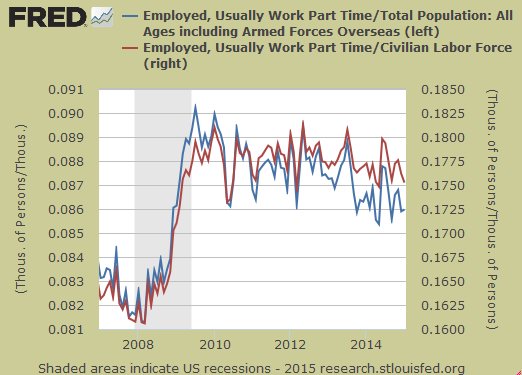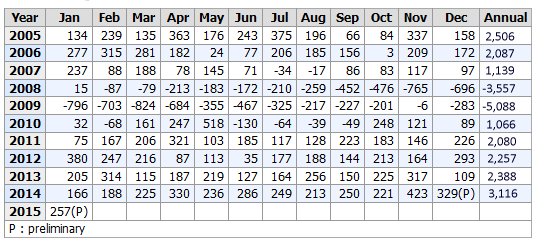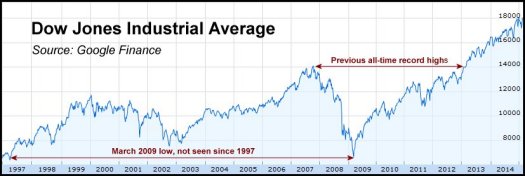In the month of September 1945, the U.S. had a loss of 1,967,000 jobs, because World War II had ended. In the month of September 1983, the Bureau of Labor Statistics showed a gain of 1,115,000 jobs. But the recovery during Ronald Reagan's presidency did not include any month in which one million jobs were actually created — but it did include one month in which almost 700,000 striking AT&T workers had returned to work.
From February 2008 to December 2009 (over a period of 23 continuous months), the Bureau of Labor Statistics shows consecutive monthly job losses totaling over 8 million, as shown in the chart below from the Bureau of Labors Statistics.
In the month of March 2009 alone, there was a loss of 824,000 jobs. That was also the same month when the Dow Jones fell to its lowest level since 1997 — when the Dow closed below 6,700 points (but as of this post, the Dow Jones is currently over 18,100 points.)
During this period of time, while still experiencing monthly job losses, the U.S. government reported that June 2009 was the official end of the Great Recession (because job losses and unemployment numbers are supposed to be "lagging indicators" of the economy when compared to GDP statistics (or how the the stock market is doing).
Since this period of heavy job losses, and since the U.S. "economic recovery" began, there have been many reports about the growing number of "independent contractors" (freelancers), temp workers and part-time workers.
Federal Reserve of Atlanta: Are We Becoming a Part Time Economy? "Compared with 2007, the U.S. labor market now has about 2.5 million more people working part-time and about 2.2 million fewer people working full-time. In this sense, U.S. businesses are more reliant on part-time workers now than in the past."

It's often mentioned that the U.S. now has a new "gig economy" — as in this recent article at Fast Company, where it says:
Full-time employment has been falling for years. Between 1995 and 2005, when the government kept data on what it calls "contingent workers," about 30% of the labor force fell into this non-full-time-employment category. In 2009, employment law firm Littler Mendelson estimated in a report that about half of the jobs added after the recession will be contingent, making the workforce 35% freelance, temp, and part-time workers. A year later, Intuit had estimated that it will be more like 40%. Meanwhile, the United States has a record number of 2.87 million temp workers, who arguably occupy the bleakest corner of the contingent worker universe ... But the gig economy can also be interpreted as a loophole for avoiding labor laws ... Robert Reich, a political economist and the former secretary of labor, compares it to the piecework system of the late 19th century, the very same system that led to trade unions and labor protections in the first place. "There is no economic security, there is no predictability, and there is no power among workers to get a fair share of the profits," he says. "You and I and everybody else, if the present trends continue, will be selling what we do to the highest bidder."
Even with budget cuts (and excluding the U.S. military and Post Office), the U.S. government is still America's largest job creator, currently with about 2.1 million employees — even though Speaker John Boehner always insists that "government" doesn't create jobs.
Walmart (a private-sector employer) is America's second largest job creator with more than 1.4 million domestic employees. According to an earlier Reuters survey of 52 stores run by the largest U.S. private employers, 27 of them were only hiring temporary workers — including Walmart, which calls their temp employees "flexible associates". In a recent public relations ploy, Walmart announced that they will begin paying their lowest-level workers $9 an hour starting this spring (which is only 19 cents more than was last reported they paid their average "associate") — and $8.81 per hour translates to an annual pay of $15,576 based upon Walmart's full-time status of 34 hours per week. Walmart says they will raise their minimum wage to $10 in 2016 — while paying its “department managers” a minimum wage of $13 per hour this year and $15 next year. At $10 an hour, two full-time employees working 40 hours a week will gross $41,600 a year (which is still less than the median household income). But while Walmart will raise it's employees hourly rate, they'll also reduce hours, making it harder to be a full-time employee — and most likely, they will use more temp workers.
America's third largest job creator is a temp agency called Kelly Services, which provided employment to 555,000 employees in 2014. Then there's McDonald's with 440,000 U.S. employees and UPS with 344,000 U.S. employees — who also uses thousands of temp workers, just as Amazon and a host of other major U.S. corporations do (if they aren't offshoring or using guestworker visas).
Money News: "The supply of unskilled labor is still pretty plentiful," said George Corona, chief operations officer at Kelly Services, one of the country's largest providers of temporary employees for light assembly plants and distribution centers ... Staffing agencies have played a growing role in the U.S. economy as companies have relied increasingly on temp hires. Temporary jobs accounted for a record-high 2.1 percent of total employment last year, about twice its share in 1990."
Times Record: "While 2014 was the strongest year of job gains in the recovery from the 2007-09 recession, rising output is not yet translating into substantial wage gains for the workers of Kelly Services, one of the country’s largest providers of temporary employees."
The New York Times reports (in a post titled "The Changing Face of Temporary Employment") the National Employment Law Project voices dismay about the strong growth in temp jobs and released a report warning that temp work often means a pay cut and can be more dangerous than regular jobs. The report says median pay for temps is about $3.40 an hour less than for the typical private-sector worker. The report also says that 42 percent of temp jobs (up from 28 percent in 1990) are light industrial — about twice the percentage of office and administration temp jobs.
From the report by the National Employment Law Project (NELP): Temp Work At An All Time High Rise of Temp Work:
More than 12 million people flowed into and out of a staffing agency in 2013 alone ... America’s staffing industry has also shifted its reach to new sectors like manufacturing and warehousing. The use of third-party staffing agencies creates a layered employment structure that empowers the client/employers at the top and puts downward pressure on staffing agencies in the middle competing for contracts. Many of those agencies in turn keep costs low by cutting corners on pay and safety for workers. In fact, staffing workers' median hourly wages are 22 percent lower than wages of all private-sector workers...
In fact, "temp work" is becoming a misnomer — with many workers in “temporary jobs” for months or years, doing the same work as their direct-hire counterparts, but for lower pay, few benefits, and no job security. When staffing workers lose their jobs, arcane rules keep many from receiving the benefits to which other unemployed workers are entitled. With more than three quarters of Fortune 500 firms now relying on third-party logistics firms to manage their warehouses, temporary work is not only growing, it is shifting from administrative jobs to low-skill blue-collar occupations. Jobs in transportation and material moving and production now account for 42 percent of the temp industry...
The fractured employment structure created by employers’ reliance on third-party staffing agencies causes confusion over who is ultimately responsible for the workers, and increases the likelihood of labor law violations. A shortsighted 2004 National Labor Relations Board decision makes it next to impossible for temp workers to unionize...
From the Bureau of Labor Statistics' last JOLTS report (Job Openings and Labor Turnover Summary): "Over the 12 months ending in December 2014, hires totaled 58.3 million and separations totaled 55.4 million, yielding a net employment gain of 2.9 million. These figures include workers who may have been hired and separated more than once during the year."
To put this into perspective: The Bureau of Labor Statistics says we have a labor force of 155.5 million workers. So that means, on average, over the course of one year, well over 1/3 of the entire labor force is playing Musical Chairs with churn in the labor market. Could this be because of the dramatic rise in “temp workers” and "independent contractors"?
Meanwhile, Monster.Com (while hailing the supposed "perks" of temp jobs) reports, "According to the American Staffing Association, the average tenure of temporary and contract employees ranges from three to five months. The number of workers employed through temp agencies climbed to a new high in 2014 — 2.87 million, according to the Bureau of Labor Statistics, and they represent a record share of the nation’s workforce."
So while "temp jobs" themselves may only be temporary, it appears that the trend in using temp workers might not be.
* Related Post: Wage Theft —> How Two States are Fighting Against Companies that Categorize Employees as Independent Contractors




Comments
part-time isn't necessarily temporary
I think the net gains by JOLTS are the closest one can get to real labor flows and this would show temporary to some degree, but does not show the "carousel" of revolving people who are working temporary and then being without work for a long time period to then later get another temporary job.
In Service Sector, No Rest for the Working
New York Times:
Employees are literally losing sleep as restaurants, retailers and many other businesses shrink the intervals between shifts and rely on smaller, leaner staffs to shave costs. These scheduling practices can take a toll on employees who have to squeeze commuting, family duties and sleep into fewer hours between shifts.
http://www.nytimes.com/2015/02/22/business/late-to-bed-early-to-rise-and...
61% new jobs in low-paying industries
St. Louis Fed:
"Since June 2009, private-sector employment has increased by about 10 million, more than offsetting the decline that occurred during the recession. However, unlike in the recession, the majority of job gains were in the low-paying industries. Of the 10 million increase in private nonfarm jobs during the current expansion, about 61 percent, 6.1 million, were in low-paying industries ... In particular, job growth in the retail trade, education and health services, and leisure and hospitality industries was responsible for almost half of total job growth during the recovery. In high-paying industries, job growth was especially strong in business services, which has accounted for about a third of the private-sector job gains during the recovery."
https://www.stlouisfed.org/~/media/Publications/Regional%20Economist/201...
Robert Reich: We’re All Becoming Independent Contractors
(February 22, 2015)
The rise of “independent contractors” is the most significant legal trend in the American workforce – contributing directly to low pay, irregular hours, and job insecurity. What makes them “independent contractors” is the mainly that the companies they work for say they are. So those companies don’t have to pick up the costs of having full-time employees. It’s become a race to the bottom. Once one business cuts costs by making its workers “independent contractors,” every other business in that industry has to do the same – or face shrinking profits and a dwindling share of the market ... They take these jobs because they can’t find better ones. And as the race to the bottom accelerates, they have fewer and fewer alternatives.
http://robertreich.org/post/111784272135
Dean Baker on TPP -- funny as Hell -- at TruthOut:
"Anything is fair game when the political establishment wants to pass major trade agreements like NAFTA or the Trans-Pacific Partnership. At such times we see respectable Washington types making pronouncements bearing so little relationship to reality they would cause Sarah Palin to cringe...It is only when the question is one of jobs for U.S. workers that the risk of such a rebellion becomes an unacceptable price. Finally the bad story that we are supposed to fear, “scuttling the entire project,” should arouse howls of derision everywhere. Wow, all those industry folks spent years trying to craft a deal that would boost their profits by circumventing laws and regulations in the U.S. and elsewhere, and now their efforts may prove pointless? Pass the handkerchief, I can’t hold back the tears."
http://www.truth-out.org/opinion/item/29238-trade-crazy-the-push-for-fas...
You try living on $900 a month
He says he constantly begs his managers at Walmart for full-time work. He generally works around 28 hours a week, but can be assigned as few as 18. He supports his fiancée on an income that can be as little as $900 a month. After spending about $550 on rent, $65 on gas for his car, as well as paying for food, diapers, cellphone costs and insurance, he can rarely afford new clothes or recreation.
Walmart says about half of its hourly-wage workers work part time, and that percentage can be even higher at other retailers. In 2007, about 685,000 of a total of 19.2 million workers in the retail sector were involuntarily employed part time, according to the Bureau of Labor Statistics. By 2014, the number of involuntary part-time retail workers had more than doubled, to 1.4 million, even as the total number of retail workers declined to 18.9 million.
http://www.nytimes.com/2015/02/26/business/next-goal-for-walmart-workers...
Home Depot goes on a temp-worker hiring spree
Mega-supply store Home Depot plans to add about 80,000 temporary workers for the spring season. At Home Depot, hiring occurs each spring when the company brings in temp workers for around three months. In this regard, it's no different than any other retailer, says Stephan Holmes, a Home Depot spokesman.
http://www.marketplace.org/topics/business/home-depot-goes-temp-worker-h...
*Remember that JOLTS report?
Home Depot also said it would buy back $18 billion in shares.
http://www.nytimes.com/2015/02/25/business/west-coast-port-gridlock-hits...
Meanwhile, Home Depot's "sales associates" earn $8.42 an hour.
http://bud-meyers.blogspot.com/2013/03/greedy-bigoted-home-depot-co-foun...
With temp work becoming permanent, reform is needed
Companies must end their reliance on temporary employees.
http://www.mndaily.com/opinion/columns/2015/02/15/temp-work-becoming-per...